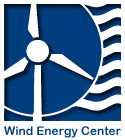Abstract
While the offshore wind energy industry in Europe has decades of experience, special conditions off the coast of North America raise new challenges that must be addressed. This presentation will address two different issues where the US experience may differ from the European experience.
First, hurricanes pose potential risks to offshore wind farms along the US East Coast. Quantification of this risk can ensure the safety, availability, and reliability of this important energy source. While limited observations of the high-frequency variability of winds, atmospheric large-eddy simulations can provide insight into the hurricane boundary layer. Using large-eddy simulations of a Category 5 hurricane, we quantify the gust factors, spatial coherence, velocity spectra, wind shear profiles, wind veer profiles, and rate-of-change of wind directions possible in such storms. We find the gusts and shear within hurricane eyewalls can exceed offshore wind turbine design standards, suggesting that financial instruments for risk mitigation will be required for the cases of direct hurricane eyewall strikes on offshore wind farms.
Next, large clusters of wind turbines can generate wind farm wakes than undermine a downwind wind farm’s power generation and revenue. Our simulations of such wakes onshore have shown that wakes can extend 50+ km downwind onshore during stably stratified atmospheric conditions, leading to potential economic impacts of several millions of dollars. Measurements of such wakes from offshore wind farms in the North Sea have also shown wakes extending for considerable distances. By evaluating our simulations of offshore wind farms wakes in comparison to the aircraft measurements carried out by European partners, we validate a simulation tool that can be used to predict wakes from windfarms off the East Coast. Lidar measurements off the East Coast suggest a preponderance of low-turbulence conditions. Especially in summertime, these wakes will be frequent and potent, and must be considered in wind energy grid integration studies for the US East Coast.
These two studies demonstrate some of the unique challenges that offshore wind energy deployment will encounter off the US East Coast. Numerical simulations of the atmosphere can provide the insights required to prepare for these challenges.
Biosketch
Prof. Lundquist leads an interdisciplinary research group in the Dept. of Atmospheric and Oceanic Sciences, University of Colorado, with a joint appointment at the National Renewable Energy Laboratory. Her research group uses observational and computational approaches to understand the atmospheric boundary layer, with emphasis on atmospheric influences on turbine productivity, turbine wake dynamics, and downwind impacts of wind energy. Before joining CU-Boulder, Dr. Lundquist designed and led wind energy projects at Lawrence Livermore National Laboratory. Her Ph.D. is in Astrophysical, Planetary, and Atmospheric Science from CU-Boulder, as is her M.S. degree. She studied English and Physics as an undergraduate at Trinity University, San Antonio, Texas. She has authored or co-authored over 75 refereed publications and over 200 conference presentations. Beyond wind energy, her current research projects include assessment of dissipation rate in the atmospheric boundary layer (NSF-CAREER), flow in complex terrain (NSF: Perdigão), and improving simulation capabilities for wildfire (DOI) and urban fires (OPP).

